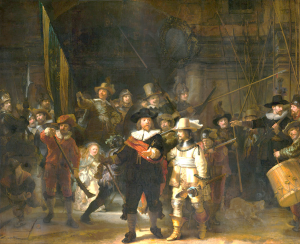By Jochen Markhorst
More than five years ago, on March 8, 2020, Tony posted here on Untold “Desolation Row – The Origins of the Title”, being Chapter 1 of my attempt to write an article about “Desolation Row”, which got a bit out of control.
It led to a 17-chapter book (available on Amazon). We then promised to post some chapters here, though. A promise that somehow floated away over the Waters of Oblivion after one publication (about the Ophelia stanza, 18 March 2020).
And today, more than five years later, it washed ashore again.
Desolation Row: The artist knew their faces well
I Rembrandt
On November 23, 1973, King Crimson play one of their best concerts in the Amsterdam Concertgebouw. The bootleg recording circulated in fan circles for years, until it is finally officially released in 1997. It is a double CD and receives the title of the sixth song from the set list (fifth song on the CD), the then unknown, and this evening partly improvised, “The Night Watch”. Which is appropriate: Rembrandt’s Night Watch hangs in the Rijksmuseum, across the street from the Concertgebouw – just cross Museumplein, a five-minute walk. That is where lyricist Richard Palmer-James got his inspiration:
The artist knew their faces well The husbands of his lady friends His creditors and councillors In armour bright, the merchant men Official moments of the guild In poses keen from bygone days
The recording is used for the first official release of the song, on Starless And Bible Black (1974).
King Crimson – The Night Watch:
“The company of Captain Frans Banninck Cocq and Lieutenant Willem van Ruytenburgh is getting ready to march”, the original title of Rembrandt’s Night Watch (1642), is a restless riot squad. It is a militia piece, but the militia is not portrayed, as usual, posing in a static arrangement, but rather while they are still grouping. Light falls on a girl who has no business here, a dog runs around through the legs, in the background we see Rembrandt himself peeking over a shoulder, the firing musketeer wears an outdated uniform from a century ago – he comes from another time.
It is an explosion of light, colour and movement, a dramatic symphony, and yet in balance; just like the refrain line of “Desolation Row” holds all images, unrelated persons and contextless actions together, Rembrandt paints a coherent disorder along perpendicular composition lines (arms, lances, guns).
It is an exceptional masterpiece. It is Rembrandt’s “Desolation Row”.
II Cinderella the slut
“A cultural pessimistic view of a crumbling America,” is the tenor of most analyses that attempt to produce a comprehensive, general interpretation of the lyrics.
“One of the most immaculately frightful visions ever set to music,” writes Mark Polizzotti, who apparently has the great fortune that he never had a catchy little Death Metal tune on his turntable (in his very worthy monograph Highway 61 Revisited, 2006). Mike Marqusee calls it “the experience of history recast as phantasmagoria.” Enviable fancy five-dollar words, and the colleagues don’t lag behind.
“This far out vision depicts a totalitarian world,” says Clinton Heylin in his standard work Revolution In The Air, 2009. Greil Marcus: “A circus of grotesques”, Robert Shelton: “one of the strongest expressions of apocalypse”, “a Vision of Sin,” Christopher Ricks “a Nietzschean nightmare,” thinks John Hughes and Sean Wilentz sees, “shards of a civilization that has gone to pieces” … the entire premier division of Dylan watchers kinda agrees.
Desolation Row is then usually a metaphor for a state of mind, or a state of enlightenment, that depicts insight; “Being on Desolation Row” is like getting out, not participating in a perverted society, seeing a truth.
Reactive reasoning then tries to press the tableaus, the archetypes and the actions described into that mould, with varying success.
The fishermen’s flowers are the works of art that artists like Dylan give to the world, the Titanic symbolizes the demise of the powerful elite, Ophelia refers to (artists like) Joan Baez, who do not understand the way of the world, Professor Ricks once again tinkers something unparalleled from Einstein disguised as Robin Hood (something with the archer Robin Hood and Einstein’s Arrow of Time), Dr. Filth tries to inject “conformity”, expecting rain means you are waiting for the drug dealer and Dylan shows that the world is upside down, because Cinderella, the “icon of True Love” (?) now is a slut.
Yes, there is a lot of suffering and despair out there, Your Majesty.
Bob Dylan – Desolation Row (Live 1994):
III But it sounds good
The less hysterical view, Dylan capturing here in poetry an impression of his reality, free from prophetic ambitions and without cultural pessimistic criticism, is less popular. It is more cohesive, though.
Dylan’s self-reflection on his songs is often enough polluted by bullying, silly, and unserious “explanations”, that is true. As a Swedish radio presenter must experience in 1966:
Rainy Day Women happens to deal with a minority of, you know, cripples and orientals and, uh, you know, and the world in which they live, you realise, you know, you understand, you know. It’s another sort of a North Mexican kind of a thing, uh, very protesty. Very, very protesty. And, uh, one of the protestiest of all things I ever protested against in my protest years.
… and that is just one of many examples. But in between all the nonsense, there are plenty of more serious moments, getting longer as he gets older. And there, in the more serious moments, one Great Constant can be seen: I am just a song and dance man, I only sketch a picture of what is happening around me, je est un autre, I don’t know what politic means, I am not a voice of a generation, they are just songs, people.
This image, this conception of art, of an artist who, off the beaten track, expresses his experience of reality, Dylan has been confessing since his very first reflections on his own work: “I don’t consider anything that I write political,” he says in the early 1960s , in the (deleted) liner notes for “Let Me Die In My Footsteps” on The Freewheelin’ (1963). On stage in the Royal Albert Hall, May 27, 1966, he even gets a little pissed, after a performance of “Leopard-Skin Pill-Box Hat”:
What you’re just hearing here now is the sound of the songs…you’re not hearing anything else except the songs, the sound…of the words…and sounds…so, you know, you can take it or leave it. (…) I’m sick of people asking, “what does it mean?” It means nothing.
Fifty years later, in his Nobel Prize Speech (2017), the gist of his self-analysis is still the same:
“If a song moves you, that’s all that’s important. I don’t have to know what a song means. I’ve written all kinds of things into my songs. And I’m not going to worry about it – what it all means. (…) But it sounds good. And you want your songs to sound good.”
And in that, to sound good, Bob Dylan succeeds often enough. For example, with “Desolation Row”, his exceptional masterpiece.
It is Dylan’s “Night Watch”.
———————
Jochen is a regular reviewer of Dylan’s work on Untold. His books, in English, Dutch and German, are available via Amazon both in paperback and on Kindle. The above is, obviously, a chapter from Desolation Row: Bob Dylan’s poetic letter from 1965.
- Blood on the Tracks: Dylan’s Masterpiece in Blue
- Blonde On Blonde: Bob Dylan’s mercurial masterpiece
- Where Are You Tonight? Bob Dylan’s hushed-up classic from 1978
- Desolation Row: Bob Dylan’s poetic letter from 1965
- Basement Tapes: Bob Dylan’s Summer of 1967
- Mississippi: Bob Dylan’s midlife masterpiece
- Bob Dylan’s Greatest Hits
- John Wesley Harding: Bob Dylan meets Kafka in Nashville
- Tombstone Blues b/w Jet Pilot: Dylan’s lookin’ for the fuse
- Street-Legal: Bob Dylan’s unpolished gem from 1978
- Bringing It All Back Home: Bob Dylan’s 2nd Big Bang
- Time Out Of Mind: The Rising of an Old Master
- Crossing The Rubicon: Dylan’s latter-day classic
- Nashville Skyline: Bob Dylan’s other type of music
- Nick Drake’s River Man: A very British Masterpiece
- I Contain Multitudes: Bob Dylan’s Account of the Long Strange Trip
- Bob Dylan’s Rough And Rowdy Ways – Side B
- Bob Dylan’s High Water (for Charley Patton)
- Bob Dylan’s 1971
- Like A Rolling Stone b/w Gates Of Eden: Bob Dylan kicks open the door
- It Takes A Lot To Laugh, It Takes A Train To Cry b/w Just Like Tom Thumb’s Blues – Bob Dylan’s melancholy blues



King Crimson takes on the role of Baulzebub and warns listeners that they must not consult the the false ‘god’ (2 Kings 1) as did King Ahaziah of Judah who paid with his life for doing so, the sound of the music, rather than the lyrics, playing a large part in the warning, and Rembrant’s painting serving as a symbolic reminder that the “riot squad” is readying itself should they do so.
Dylan words, in spite of what the songwriter caims, play a large part in Desolation Row wherein there are those who escape from the ‘superhuman crew’. Whistler’s Mother painting likewise serving as a symbol of needed change in “Tarantula”.